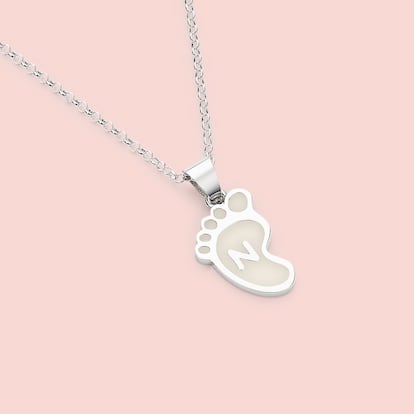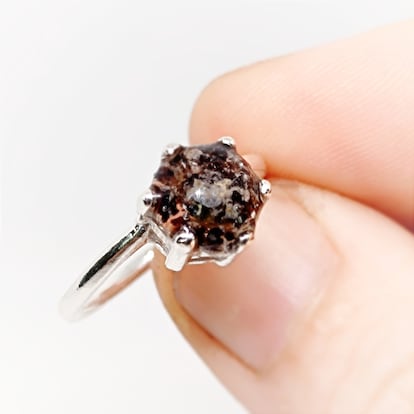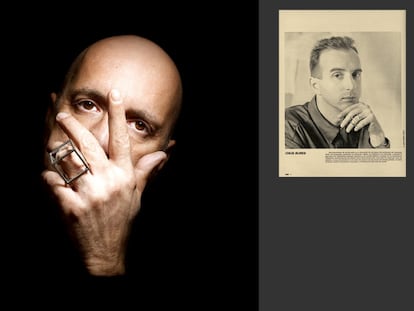Mother’s milk and umbilical cord rings: Treasured jewelry or the mythification of motherhood?
Television presenter Cristina Pedroche helped to popularize accessories designed to remind moms of their baby’s early years, made with actual biological remnants. But not all moms feel a connection to such jewels

Designer Belén Mozas began making jewelry out of mother’s milk when she was told she could never be a biological mom. “At that moment, I had only two options: sinking into depression or redirecting my path. And I decided to explore motherhood through that which I love making more than anything else, which is jewelry,” says Mozas, who is the founder of the brand Morir de Amor, specializing in “emotional jewelry.” After spending time researching how to make a material suitable for jewelry-making from mother’s milk, she hit upon “crystallizing” it and transforming it into a significance-laden accessory.
“For many years, when I spoke about the subject, people would scratch their head,” Mozas says. Until one day, when Cristina Pedroche put her trust in the designer to create her “milk ring.” Every move the TV presenter makes has an impact, and when she debuted her Morir de Amor mother’s milk ring to her social media following in February, results were immediate. Despite some blowback from a handful of followers, many of Pedroche’s fans discovered the existence of such pieces existed thanks to her post, and the brand’s orders skyrocketed.
How is milk preserved over time?
But how does one manage to transform mother’s milk into a material suitable for making jewelry? How can something that can only sit at room temperature for less than two hours, or up to four to five days in the refrigerator, become a long-lasting gem? How much milk do you need for each creation? González replies that “the perfect amount is one ounce, that’s enough for various pieces and to save a portion for at least a year as a guarantee or for if you decide you want another piece.” She describes the creation process as something “unique, the fruit of extensive research.”
“When we receive the milk, we mix it with a few drops of liquid preservative and then freeze-dry it. That way you have a jewel that is made with 100% your milk, but that will last forever, perfectly preserved. It is very important to process the milk correctly, otherwise it will spoil,” González explains. The result is jewelry that, instead of featuring a traditional gem or precious stone, features the whiteness of the milk, solidified and immortalized.

Jewelry with hair, umbilical cord or teeth: it’s not for everyone
Mother’s milk is not the only biological element that can be converted into a gem with which to stud rings and necklaces. You can also use umbilical cords and baby hair, or even baby teeth of older offspring. At jewelry brand Tesoros de Vida, designers have also employed “ashes, flowers and special fabrics.” The founder of Morir de Amor goes even further, saying that right now she is immersed in the elaboration of “a very special piece made with placenta, that wondrous organ that a woman’s body creates to give life to her baby.”
Laura Rodríguez is 32 years old and became a mother in May 2023. One of the first gifts she received was a bracelet created with umbilical cord. “I had decided to save my daughter’s cord as a souvenir, but when I saw that I could have jewelry made from the thing that united the two of us when she was inside of me, I loved the idea!” Now that her daughter is more than a year old and about to stop nursing, Rodríguez is set on getting jewelry made from her breastmilk.

But for 33-year-old María Ramos, motherhood jewelry is unconvincing. Though she did save her umbilical cord after recently giving birth, she’s not planning on using it for anything. “I love saving souvenirs of everything and documenting my daughter’s every step, but I wouldn’t make jewelry out of what’s left of the cord or my milk, even though my experience nursing was, luckily, very positive, and I always like to commemorate that kind of moment. Even though I truly understand the symbolic said that this kind of jewelry can embody, it’s not my thing.” If before, people saved their baby’s first tooth in a small box or lovingly squirreled away the locks from their first haircut, in 2024, motherhood jewelry have become the souvenir of choice among certain, nostalgic progenitors. But there are as many ways of navigating motherhood as there are women, and it’s clear that not all moms feel connected to this kind of atypical accessory.
The dangers of idealizing breastfeeding
This kind of jewelry is seen as a way to remember a supposedly beautiful time, but it is important to remember that breastfeeding is not always a bed of roses. Celia Padilla, a nurse who specializes in obstetrics and gynecology and who is the CEO of the OhMamá Matrona platform, explains that, according to data from the Spanish Pediatrics Association (AEPED), in Spain, there is a, “maternal breastfeeding rate of 77.2% when babies are six weeks old. That number falls to 66.5% after three months, and 46.9% after six months.” That is to say, 22.8% of Spanish mothers never breastfeed.
These women “who, for whatever reason, do not breastfeed their babies, are judged and criticized for it,” says breastfeeding consultant Laura Blasco, founder of Lactandcia. She adds that although, “we know that breastfeeding is the best food for all babies (…) I always say that it is not for all mothers. The mother’s mental health takes priority when it comes to the feeding method we choose for our babies.” The weeks following childbirth can be particularly challenging, and the idealization of breastfeeding can create added difficulties when things don’t work out as expected.
In the opinion of Doctor Carmela Baeza, a family doctor who specializes in breastfeeding, societal pressure can be exerted even on mothers who do breastfeed. “We live in a society that harshly judges all women who become mothers. They all feel the pressure: those who can’t or don’t want to breastfeed have to hear comments like, ‘Why don’t you breastfeed It’s the best way…’ or ‘You should try harder…’ while mothers who do choose to breastfeed get comments like, ‘You’re feeding the baby again?’ ‘The baby must be hungry.’” Beyond the idealization of breastfeeding, during her “experience over the past 25 years working with mothers and babies, the problem is that it’s not just breastfeeding that is idealized, but also what it means to have a baby — a 24/7 job full of uncertainty and doubts and at the same time, happiness. Normal breastfeeding makes caring for a baby simpler and more comfortable, but breastfeeding with complications can make postpartum incredibly difficult.”
Sign up for our weekly newsletter to get more English-language news coverage from EL PAÍS USA Edition
Tu suscripción se está usando en otro dispositivo
¿Quieres añadir otro usuario a tu suscripción?
Si continúas leyendo en este dispositivo, no se podrá leer en el otro.
FlechaTu suscripción se está usando en otro dispositivo y solo puedes acceder a EL PAÍS desde un dispositivo a la vez.
Si quieres compartir tu cuenta, cambia tu suscripción a la modalidad Premium, así podrás añadir otro usuario. Cada uno accederá con su propia cuenta de email, lo que os permitirá personalizar vuestra experiencia en EL PAÍS.
¿Tienes una suscripción de empresa? Accede aquí para contratar más cuentas.
En el caso de no saber quién está usando tu cuenta, te recomendamos cambiar tu contraseña aquí.
Si decides continuar compartiendo tu cuenta, este mensaje se mostrará en tu dispositivo y en el de la otra persona que está usando tu cuenta de forma indefinida, afectando a tu experiencia de lectura. Puedes consultar aquí los términos y condiciones de la suscripción digital.
More information
Archived In
Últimas noticias
Most viewed
- Sinaloa Cartel war is taking its toll on Los Chapitos
- Reinhard Genzel, Nobel laureate in physics: ‘One-minute videos will never give you the truth’
- Oona Chaplin: ‘I told James Cameron that I was living in a treehouse and starting a permaculture project with a friend’
- Why the price of coffee has skyrocketed: from Brazilian plantations to specialty coffee houses
- David King, chemist: ‘There are scientists studying how to cool the planet; nobody should stop these experiments from happening’











































